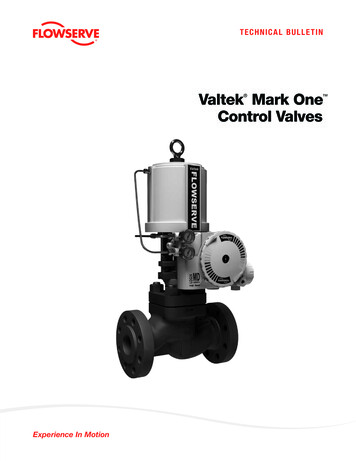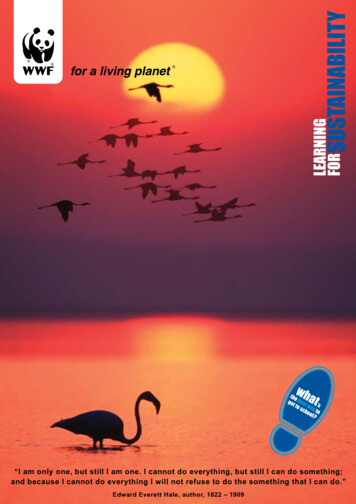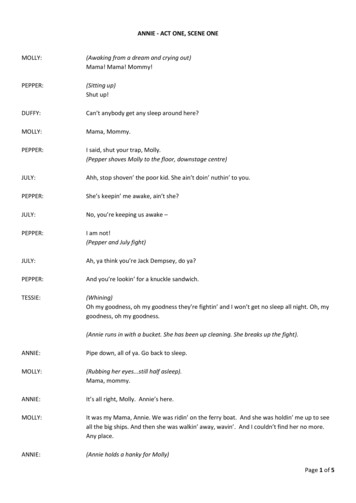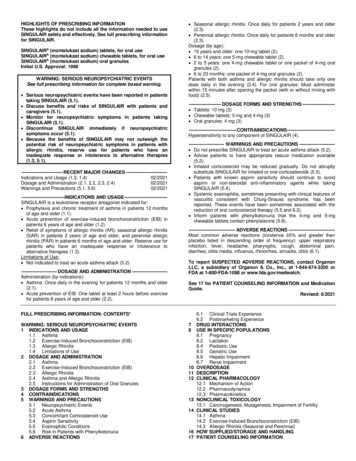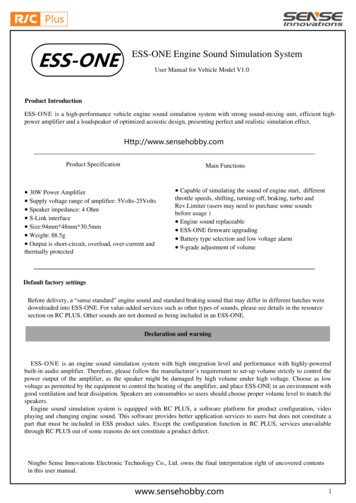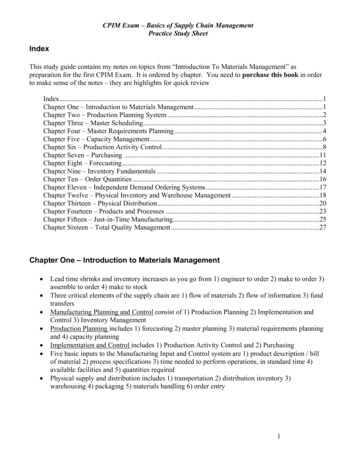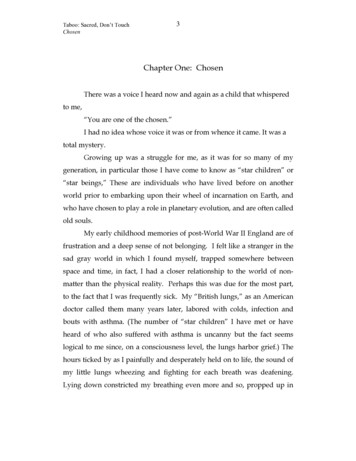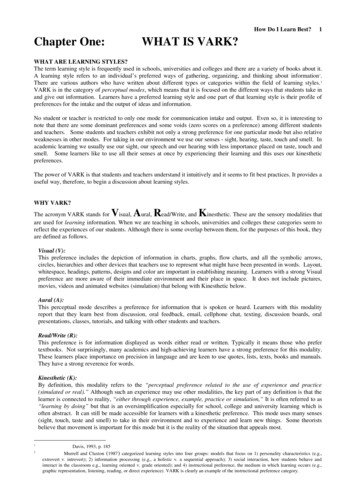
Transcription
How Do I Learn Best?Chapter One:1WHAT IS VARK?WHAT ARE LEARNING STYLES?The term learning style is frequently used in schools, universities and colleges and there are a variety of books about it.A learning style refers to an individual’s preferred ways of gathering, organizing, and thinking about information1.There are various authors who have written about different types or categories within the field of learning styles. 2VARK is in the category of perceptual modes, which means that it is focused on the different ways that students take inand give out information. Learners have a preferred learning style and one part of that learning style is their profile ofpreferences for the intake and the output of ideas and information.No student or teacher is restricted to only one mode for communication intake and output. Even so, it is interesting tonote that there are some dominant preferences and some voids (zero scores on a preference) among different studentsand teachers. Some students and teachers exhibit not only a strong preference for one particular mode but also relativeweaknesses in other modes. For taking in our environment we use our senses - sight, hearing, taste, touch and smell. Inacademic learning we usually use our sight, our speech and our hearing with less importance placed on taste, touch andsmell. Some learners like to use all their senses at once by experiencing their learning and this uses our kinestheticpreferences.The power of VARK is that students and teachers understand it intuitively and it seems to fit best practices. It provides auseful way, therefore, to begin a discussion about learning styles.WHY VARK?VARKThe acronym VARK stands forisual,ural,ead/Write, andinesthetic. These are the sensory modalities thatare used for learning information. When we are teaching in schools, universities and colleges these categories seem toreflect the experiences of our students. Although there is some overlap between them, for the purposes of this book, theyare defined as follows.Visual (V):This preference includes the depiction of information in charts, graphs, flow charts, and all the symbolic arrows,circles, hierarchies and other devices that teachers use to represent what might have been presented in words. Layout,whitespace, headings, patterns, designs and color are important in establishing meaning. Learners with a strong Visualpreference are more aware of their immediate environment and their place in space. It does not include pictures,movies, videos and animated websites (simulation) that belong with Kinesthetic below.Aural (A):This perceptual mode describes a preference for information that is spoken or heard. Learners with this modalityreport that they learn best from discussion, oral feedback, email, cellphone chat, texting, discussion boards, oralpresentations, classes, tutorials, and talking with other students and teachers.Read/Write (R):This preference is for information displayed as words either read or written. Typically it means those who prefertextbooks. Not surprisingly, many academics and high-achieving learners have a strong preference for this modality.These learners place importance on precision in language and are keen to use quotes, lists, texts, books and manuals.They have a strong reverence for words.Kinesthetic (K):By definition, this modality refers to the “perceptual preference related to the use of experience and practice(simulated or real).” Although such an experience may use other modalities, the key part of any definition is that thelearner is connected to reality, “either through experience, example, practice or simulation,” It is often referred to as“learning by doing” but that is an oversimplification especially for school, college and university learning which isoften abstract. It can still be made accessible for learners with a kinesthetic preference. This mode uses many senses(sight, touch, taste and smell) to take in their environment and to experience and learn new things. Some theoristsbelieve that movement is important for this mode but it is the reality of the situation that appeals most.12Davis, 1993, p. 185Murrell and Claxton (1987) categorized learning styles into four groups: models that focus on 1) personality characteristics (e.g.,extrovert v. introvert); 2) information processing (e.g., a holistic v. a sequential approach); 3) social interaction, how students behave andinteract in the classroom e.g., learning oriented v. grade oriented); and 4) instructional preference, the medium in which learning occurs (e.g.,graphic representation, listening, reading, or direct experience). VARK is clearly an example of the instructional preference category.
2How Do I Learn Best?Before you read any further you should complete the 16 questions below. It is not a test, but it will make more sense ofwhat you are about to read. There are some instructions at the top of the questionnaire. Not everybody reads them. Themost important instruction is that you may have more than one answer to any of the questions. It will be somewhatmore interesting if you limit yourself to one answer per question or maybe two, but that is your choice. Please fill in thequestionnaire even if you have filled it in before. Just one more time! If you prefer to complete the questionnaire onlinego to www.vark-learn.com get your scores and return to the section on Scoring on page 4. 3The VARK questionnaire indicates your preferences for the way you work with information. Choose the answer whichbest explains your preference and circle the letter next to it. Please circle more than one answer if a single answer doesnot match your perception. Leave blank any question that does not apply. When you have completed the questionnaireyou should fill in the boxes on page 3 and record your profile of preferences.THE VARK QUESTIONNAIREChoose the answer which best explains your preference and circle the letter(s) next to it. Please circlemore than one if a single answer does not match your perception. Leave blank any question that does notapply.1.You are helping someone who wants to go to your airport, town centre or railway station. You would:a)draw, or give her a map.b)tell her the directions.c)write down the directions (without a map).d)go with her.2.You are not sure whether a word should be spelled dependent' or dependant'. You would:a)see the word in your mind and choose by the way they look.b)think about how each word sounds and choose one.c)find it in a dictionary.d)write both words on paper and choose one.3.You are planning a holiday for a group. You want some feedback from them about the plan. Youwould:a)use a map or website to show them the places.b)phone, text or email them.c)give them a copy of the printed itinerary.d)describe some of the highlights.4.You are going to cook something as a special treat for your family. You would:a)look through the cookbook for ideas from the pictures.b)ask friends for suggestions.c)use a cookbook where you know there is a good recipe.d)cook something you know without the need for instructions.5.A group of tourists want to learn about the parks or wildlife reserves in your area. You would:a)show them internet pictures, photographs or picture books.b)talk about, or arrange a talk for them about parks or wildlife reserves.c)give them a book or pamphlets about the parks or wildlife reserves.d)take them to a park or wildlife reserve and walk with them.6.You are about to purchase a digital camera or mobile phone. Other than price, what would mostinfluence your decision?a)It is a modern design and looks good.b)The salesperson telling me about its features.c)Reading the details about its features.d)Trying or testing it.3This questionnaire is online at the website: www.vark-learn.com.
How Do I Learn Best?37.Remember a time when you learned how to do something new. Try to avoid choosing a physicalskill, e.g. riding a bike. You learned best by:a)diagrams and charts - visual clues.b)listening to somebody explaining it and asking questions.c)written instructions – e.g. a manual or textbook.d)watching a demonstration.8.You have a problem with your knee. You would prefer that the doctor:a)showed you a diagram of what was wrong.b)described what was wrong.c)gave you a web address or something to read about it.d)used a plastic model of a knee to show what was wrong.9.You want to learn a new program, skill or game on a computer. You would:a)follow the diagrams in the book that came with it.b)talk with people who know about the program.c)read the written instructions that came with the program.d)use the controls or keyboard.10.I like websites that have:a)interesting design and visual features.b)audio channels where I can hear music, radio programs or interviews.c)interesting written descriptions, lists and explanations.d)things I can click on, shift or try.11.Other than price, what would most influence your decision to buy a new non-fiction book?a)The way it looks is appealing.b)A friend talks about it and recommends it.c)Quickly reading parts of it.d)It has real-life stories, experiences and examples.12.You are using a book, CD or website to learn how to take photos with your new digital camera. Youwould like to have:a)diagrams showing the camera and what each part does.b)a chance to ask questions and talk about the camera and its features.c)clear written instructions with lists and bullet points about what to do.d)many examples of good and poor photos and how to improve them.13.Do you prefer a teacher or a presenter who uses:a)diagrams, charts or graphs.b)question and answer, talk, group discussion, or guest speakers.c)handouts, books, or readings.d)demonstrations, models or practical sessions.14.You have finished a competition or test and would like some feedback. You would like to havefeedback:a)using graphs showing what you had achieved.b)from somebody who talks it through with you.c)using a written description of your results.d)using examples from what you have done.15.You are going to choose food at a restaurant or cafe. You would:a)look at what others are eating or look at pictures of each dish.b)ask the waiter or friends to recommend choices.c)choose from the descriptions in the menu.d)choose something that you have had there before.
4How Do I Learn Best?16.You have to make an important speech at a conference or special occasion. You would:a)make diagrams or get graphs to help explain things.b)write a few key words and practise saying your speech over and over.c)write out your speech and learn from reading it over several times.d)gather many examples and stories to make the talk real and practical.Please fill in these boxes to record your profile of preferences.Count thea)b)c)d)RKTotal for the questionnaireVAYou will need the total of your four scores. The total of my four scores is:SCORINGBecause you could choose more than one answer for each question, the scoring is not just a simple matter of counting. Itis like four stepping-stones across some water. Enter your scores from highest to lowest on the four stones below. Nowadd their V, A, R, and K labels beside them on the stone.Your stepping distance comes from this table.The total of my four VARK scores is 14-2122-2728-32More than 32My stepping distance is1234
How Do I Learn Best?FOLLOW THESE STEPS TO ESTABLISH YOUR PREFERENCES.Step OneYour first preference is always your highest score so tick (check) that first stone as one of yourpreferences.Step Two5Subtract your second highest score from your highest score. If the answer is larger than your steppingdistance go to the paragraph on the next page titled: What is the strength of my single preference? Ifnot, tick this stone as a second preference and continue with Step Three below.Step Three Subtract your third highest score from your second highest. If the answer is larger than your steppingdistance go to the paragraph titled: Bi-modal Preferences. If not, tick this stone as a third preference andcontinue with Step Four below.Step FourLastly, subtract your fourth highest score from your third highest. If the answer is larger than yourstepping distance go to the paragraph headed: Tri-Modal Preferences. Otherwise, tick your fourth stoneas another preference and read the paragraph titled: All Four are Preferences!BI-MODAL PREFERENCESIf you checked two preferences you are bi-modal. You are also part of the large group who are multimodal – those whohave more than one preference. Your preferences will be one of the combinations below.VAAn example:MarceloVRTotal score 16Stepping Distance 1VK3VAR3AAK5RRK5KMarcelo has a bi-modal preference for Read/write and Kinesthetic. Now go to the paragraph titled: What is Normal?TRI-MODAL PREFERENCESIf you checked three preferences you are tri-modal. You are also part of the larger group who are multimodal – thosewho have more than one preference. Your preferences will be one of these combinations below.VARVAKVRKARKAn example:AdamTotal scores 22Stepping Distance 28V7A1R6KAdam is multimodal with three preferences (V, A and K). His strongest choice (V) is little different from his others (Aand K). Now go to the paragraph titled: What is Normal?ALL FOUR ARE PREFERENCES!You have checked all four modes (V, A, R and K). They are of similar importance among your preferences forinformation input and output. You are part of the large group who are multimodal – those who have more than onepreference. Now go to the paragraph titled: What is Normal?WHAT IS THE STRENGTH OF MY SINGLE PREFERENCE?Total number ofresponses?Up to 2122-2728-3233 The difference between my highest score and my next highest score is?Ties 06 4 or 52 or 30 or 17 5 or 63 or 4Less than 38 6 or 74 or 5Less than 49 7 or 85 or 6Less than 5You have aVery StrongPreferenceYou have aStrongPreferenceYou have aMildPreferenceYou have no singlepreference. You like touse all fourThis paragraph is for those who have a single preference. They have their highest score well above the others.
THE VARK QUESTIONNAIRE Choose the answer which best explains your preference and circle the letter(s) next to it. Please circle more than one if a single answer does not match your perception. Leave blank any question that does not apply. 1. You are helping someone who wants to go to your airport, town centre or railway station. You would: a) draw, or give her a map. b) tell her the directions .


